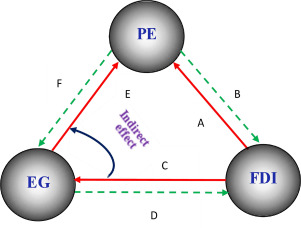当前位置:
X-MOL 学术
›
Environ. Impact Assess. Rev.
›
论文详情
Our official English website, www.x-mol.net, welcomes your
feedback! (Note: you will need to create a separate account there.)
Assessing the impact of FDI on PM2.5 concentrations: A nonlinear panel data analysis for emerging economies
Environmental Impact Assessment Review ( IF 9.8 ) Pub Date : 2020-01-01 , DOI: 10.1016/j.eiar.2019.106314 Qichang Xie , Qiankun Sun
Environmental Impact Assessment Review ( IF 9.8 ) Pub Date : 2020-01-01 , DOI: 10.1016/j.eiar.2019.106314 Qichang Xie , Qiankun Sun

|
Abstract While emerging markets have obtained powerful growth for foreign direct investment (FDI) inflows, they are facing severe smog pollution, and this contradiction has become increasingly prominent since the financial crisis. Assessing the influence of FDI on pollutant emissions is of great significance for determining how to attract FDI to promote environmental sustainability. The present study simultaneously investigates the direct and indirect effects of FDI on PM2.5 contamination for emerging countries spanning the period 2010–2016. Due to the features of the nonlinear analysis, a generalized panel smooth transition regression (GPSTR) model was introduced, and cross-sectional dependence, heterogeneity, nonlinear unit root, nonlinear cointegration tests and non-parametric kernel density estimation were applied to achieve this goal. The results reveal that FDI directly contributes to decreasing PM2.5, but indirectly has on increasing PM2.5 emissions. The total effect of FDI on PM2.5 concentrations is proven to be negative, which confirms the pollution halo hypothesis. Moreover, the connection between FDI inflows and PM2.5 emissions displays a threshold and dynamic characteristic and is “S-shaped”. At lower levels of FDI, the inflows of FDI exert a positive effect on reducing PM2.5 concentrations, whereas when FDI exceeds the threshold of 23.2981, such influence is gradually weakened with an increase in its own accumulation. The study provides new assessments on FDI's contribution to pollutant emissions and evidence for environmental sustainability in the post-financial crisis era.
中文翻译:

评估 FDI 对 PM2.5 浓度的影响:新兴经济体的非线性面板数据分析
摘要 新兴市场在外国直接投资(FDI)流入取得强劲增长的同时,也面临着严重的雾霾污染,金融危机以来这一矛盾日益突出。评估 FDI 对污染物排放的影响对于确定如何吸引 FDI 以促进环境可持续性具有重要意义。本研究同时调查了 2010-2016 年期间 FDI 对新兴国家 PM2.5 污染的直接和间接影响。针对非线性分析的特点,引入广义面板平滑过渡回归(GPSTR)模型,并应用截面相关性、异质性、非线性单位根、非线性协整检验和非参数核密度估计来实现这一目标。 . 结果表明,FDI 直接有助于降低 PM2.5,但间接有助于增加 PM2.5 排放。FDI 对 PM2.5 浓度的总体影响被证明是负面的,这证实了污染晕假说。而且,FDI流入量与PM2.5排放量之间的联系呈现出阈值和动态特征,呈“S形”。FDI 水平较低时,FDI 流入对降低 PM2.5 浓度产生积极影响,而当 FDI 超过阈值 23.2981 时,这种影响随着自身积累的增加而逐渐减弱。该研究对 FDI 对污染物排放的贡献以及后金融危机时代环境可持续性的证据提供了新的评估。但间接增加了 PM2.5 的排放量。FDI 对 PM2.5 浓度的总体影响被证明是负面的,这证实了污染晕假说。而且,FDI流入量与PM2.5排放量之间的联系呈现出阈值和动态特征,呈“S形”。FDI 水平较低时,FDI 流入对降低 PM2.5 浓度产生积极影响,而当 FDI 超过阈值 23.2981 时,这种影响随着自身积累的增加而逐渐减弱。该研究对 FDI 对污染物排放的贡献以及后金融危机时代环境可持续性的证据提供了新的评估。但间接增加了 PM2.5 的排放量。FDI 对 PM2.5 浓度的总体影响被证明是负面的,这证实了污染晕假说。而且,FDI流入量与PM2.5排放量之间的联系呈现出阈值和动态特征,呈“S形”。FDI 水平较低时,FDI 流入对降低 PM2.5 浓度产生积极影响,而当 FDI 超过阈值 23.2981 时,这种影响随着自身积累的增加而逐渐减弱。该研究对 FDI 对污染物排放的贡献以及后金融危机时代环境可持续性的证据提供了新的评估。FDI流入量与PM2.5排放量之间的联系呈现出阈值和动态特征,呈“S形”。FDI 水平较低时,FDI 流入对降低 PM2.5 浓度产生积极影响,而当 FDI 超过阈值 23.2981 时,这种影响随着自身积累的增加而逐渐减弱。该研究对 FDI 对污染物排放的贡献以及后金融危机时代环境可持续性的证据提供了新的评估。FDI流入量与PM2.5排放量之间的联系呈现出阈值和动态特征,呈“S形”。FDI 水平较低时,FDI 流入对降低 PM2.5 浓度产生积极影响,而当 FDI 超过阈值 23.2981 时,这种影响随着自身积累的增加而逐渐减弱。该研究对 FDI 对污染物排放的贡献以及后金融危机时代环境可持续性的证据提供了新的评估。
更新日期:2020-01-01
中文翻译:

评估 FDI 对 PM2.5 浓度的影响:新兴经济体的非线性面板数据分析
摘要 新兴市场在外国直接投资(FDI)流入取得强劲增长的同时,也面临着严重的雾霾污染,金融危机以来这一矛盾日益突出。评估 FDI 对污染物排放的影响对于确定如何吸引 FDI 以促进环境可持续性具有重要意义。本研究同时调查了 2010-2016 年期间 FDI 对新兴国家 PM2.5 污染的直接和间接影响。针对非线性分析的特点,引入广义面板平滑过渡回归(GPSTR)模型,并应用截面相关性、异质性、非线性单位根、非线性协整检验和非参数核密度估计来实现这一目标。 . 结果表明,FDI 直接有助于降低 PM2.5,但间接有助于增加 PM2.5 排放。FDI 对 PM2.5 浓度的总体影响被证明是负面的,这证实了污染晕假说。而且,FDI流入量与PM2.5排放量之间的联系呈现出阈值和动态特征,呈“S形”。FDI 水平较低时,FDI 流入对降低 PM2.5 浓度产生积极影响,而当 FDI 超过阈值 23.2981 时,这种影响随着自身积累的增加而逐渐减弱。该研究对 FDI 对污染物排放的贡献以及后金融危机时代环境可持续性的证据提供了新的评估。但间接增加了 PM2.5 的排放量。FDI 对 PM2.5 浓度的总体影响被证明是负面的,这证实了污染晕假说。而且,FDI流入量与PM2.5排放量之间的联系呈现出阈值和动态特征,呈“S形”。FDI 水平较低时,FDI 流入对降低 PM2.5 浓度产生积极影响,而当 FDI 超过阈值 23.2981 时,这种影响随着自身积累的增加而逐渐减弱。该研究对 FDI 对污染物排放的贡献以及后金融危机时代环境可持续性的证据提供了新的评估。但间接增加了 PM2.5 的排放量。FDI 对 PM2.5 浓度的总体影响被证明是负面的,这证实了污染晕假说。而且,FDI流入量与PM2.5排放量之间的联系呈现出阈值和动态特征,呈“S形”。FDI 水平较低时,FDI 流入对降低 PM2.5 浓度产生积极影响,而当 FDI 超过阈值 23.2981 时,这种影响随着自身积累的增加而逐渐减弱。该研究对 FDI 对污染物排放的贡献以及后金融危机时代环境可持续性的证据提供了新的评估。FDI流入量与PM2.5排放量之间的联系呈现出阈值和动态特征,呈“S形”。FDI 水平较低时,FDI 流入对降低 PM2.5 浓度产生积极影响,而当 FDI 超过阈值 23.2981 时,这种影响随着自身积累的增加而逐渐减弱。该研究对 FDI 对污染物排放的贡献以及后金融危机时代环境可持续性的证据提供了新的评估。FDI流入量与PM2.5排放量之间的联系呈现出阈值和动态特征,呈“S形”。FDI 水平较低时,FDI 流入对降低 PM2.5 浓度产生积极影响,而当 FDI 超过阈值 23.2981 时,这种影响随着自身积累的增加而逐渐减弱。该研究对 FDI 对污染物排放的贡献以及后金融危机时代环境可持续性的证据提供了新的评估。











































 京公网安备 11010802027423号
京公网安备 11010802027423号